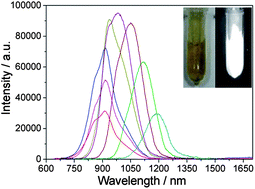Synthesis of stable near-infrared emitting HgTe/CdS core/shell nanocrystals using dihydrolipoic acid as stabilizer†
Abstract
HgTe/CdS core/shell

* Corresponding authors
a
State Key Laboratory of Analytical Chemistry for Life Science, School of Chemistry and Chemical Engineering, Nanjing University, Nanjing 210093, P. R. China
E-mail:
jsyu@nju.edu.cn
Fax: +86(25) 83594957
Tel: +86(25) 83594957
b School of Pharmacy, Nanjing Medical University, Nanjing 210029, P. R. China
HgTe/CdS core/shell

 Please wait while we load your content...
Something went wrong. Try again?
Please wait while we load your content...
Something went wrong. Try again?
W. Zhang, J. Yang and J. Yu, J. Mater. Chem., 2012, 22, 6383 DOI: 10.1039/C2JM15630J
To request permission to reproduce material from this article, please go to the Copyright Clearance Center request page.
If you are an author contributing to an RSC publication, you do not need to request permission provided correct acknowledgement is given.
If you are the author of this article, you do not need to request permission to reproduce figures and diagrams provided correct acknowledgement is given. If you want to reproduce the whole article in a third-party publication (excluding your thesis/dissertation for which permission is not required) please go to the Copyright Clearance Center request page.
Read more about how to correctly acknowledge RSC content.
 Fetching data from CrossRef.
Fetching data from CrossRef.
This may take some time to load.
Loading related content
